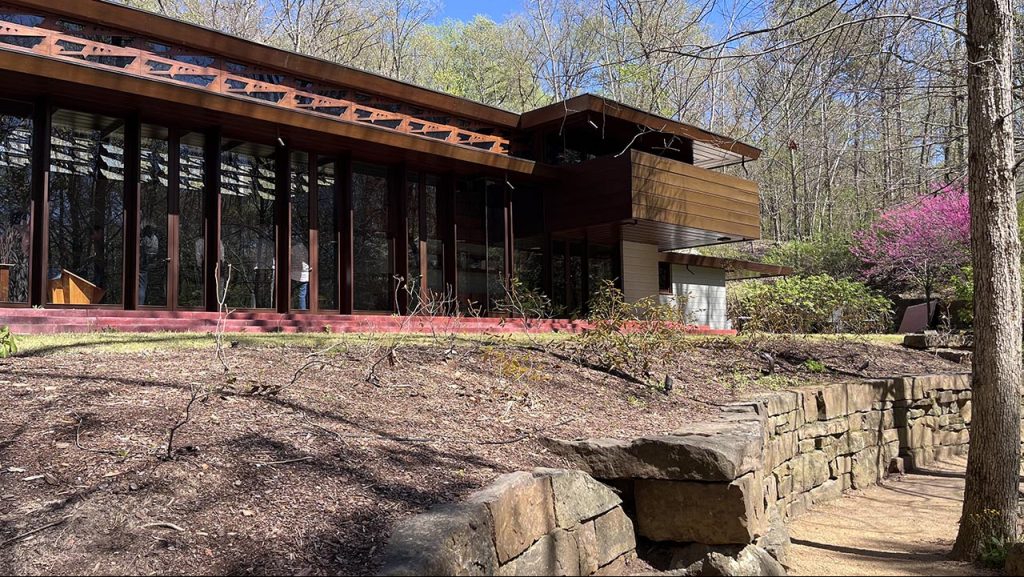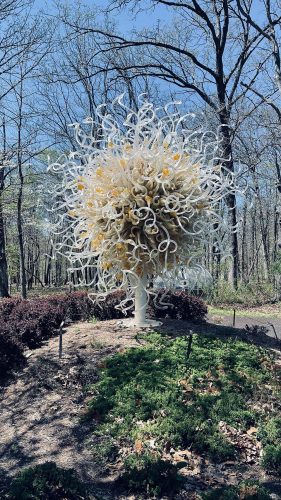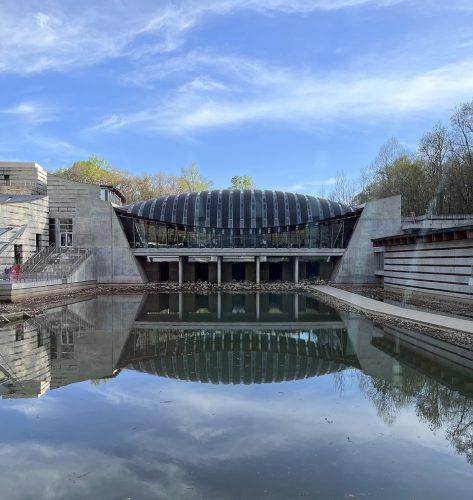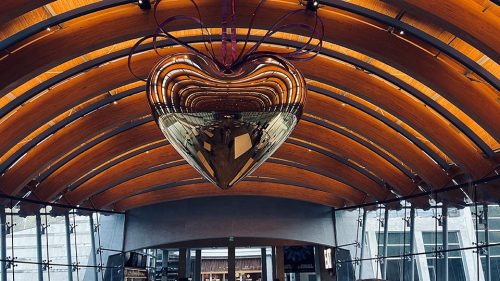Art and Nature in Harmony
Our eclipse-bound columnist was stunned by the growth and beauty of Arkansas.


Like many North Americans, I had my sights set on looking skyward on April 8. My initial motivation was triggered by learning that the total eclipse would follow an arc from Texas to Nova Scotia—and on not just any day, but on my birthday.
I envisioned a road trip ending in Bentonville, Arkansas at the Crystal Bridges American Museum of Art (CBMAA). As luck would have it, Bentonville is just two hours north of many state parks that were on the path of totality. So instead of a road trip we and two other couples took to the skies, flying directly to Bentonville.
Surely you have listened to many folks’ eclipse experiences, so I’m going to share a travelogue of sorts leading up to the grand finale—darkness. The next opportunity to experience a total eclipse in North America is now 20 years away, so instead of waiting, you might enjoy learning from our travels.
After landing at the Bentonville/Fayetteville Airport we drove through Rogers. In 2000, Rogers had 14,000 households; by 2020 there were 24,297. It is one of the fastest growing metro areas in the country. Having done little homework about the communities in advance of our trip, I expected that Arkansas—with a per capita income of $32K in the past 12 months—would be rather run down (for comparison New Jersey’s per capita income is $77K, while Millville’s is $45K). In the extremely limited stretch that we navigated, we saw all multi-million-dollar homes; Rogers’ median household income is $78K. Clearly there is diversity that was not represented in this stretch.
Rogers is the home of the first Walmart store and the company is headquartered in neighboring Bentonville. The town of Bentonville would also be our headquarters for the duration of our stay.
You surely know that Walmart is a huge retail chain. But it is impossible to realize how vast the Bentonville campuses are without visiting, and after that you still won’t know the exact extent.
Beyond employment by Walmart and corporations that offer services to the company, the Alice Walton Foundation is a major economic engine in the region. Near the entrance to the CBMAA, we saw a 154,000-square-foot medical school being built on 14 acres. Heiress Alice Walton is the medical school’s founder and it is called the Alice Walton School of Medicine, AWSOM—pronounced “awesome.” A 75,000-square-foot Whole Health Institute is slated to be completed this year. Both entities are founded by Walton. These are just two of many structures being funded by the Foundation.

There are many other construction project structures being built in Bentonville. The library is being renovated, the Walton Museum Five and Dime is closed for renovation, and two hotels, a 350-acre Walmart campus, and more are in progress.
Our interest was in seeing the CBMAA and its collections, architecture, and grounds. Walton founded the museum and takes the acquisitions of American art seriously.
When you enter the structure it is situated at a lower elevation and remains somewhat unobtrusive. However, as you descend into the space and it unveils itself you are struck by its sprawling nature; wings flank two spring-fed ponds (“Crystal Spring”), and galleries span the ponds suspended like bridges, over stepped weirs, that produce cascading waters. The bridges cross two opposing hills divided by the creek bed. The current galleries, meeting areas, classrooms, and gift shop cover 200,000 square feet. All of this is nestled on 120 acres, much of it previously farmed, that was given by the Waltons.
Opened in 2011, the museum is a non-profit charitable organization founded in 2005. Founding endowments through the Walton Family Foundation for the museum total $800 million. The museum and its grounds are free of charge to visitors. Temporary displays and travelling exhibits require reserved time slots and tickets, but remain free.
A crane towers over the museum’s valley where a additional space is being added to the facility. This will double the gallery space and allow many more pieces of art to be displayed by 2025.
The grounds have been undergoing transformation through the use of native species of plants and trees. The bluebells, celandine poppies, and ragwort were in bloom and blanketed the forest floor. Trees were budding, and those that were just beginning to leaf out still revealed large spaces between their branches, so we had great views of the complex topography while still enjoying plenty of colorful accents. We heard and saw warblers, red-bellied woodpeckers, titmice, cardinals, vireos, jays and many others. Miles of paths connect the campus to Compton Gardens and Arboretum, which are also dedicated to native species. The work of famous sculpturers are along footpaths surrounding CBMAA.
Our first two-hour visit was primarily to see famous American artists’ paintings. Our encounters included portraits of George Washington and some of the Hudson School painters like Thomas Cole. Other artists included Winslow Homer, Thomas Eakins, Maxfield Parish, Norman Rockwell, Georgia O’Keeffe, Andrew Wyeth, Thomas Hart Benton and many other American painters.
One work that I found especially quizzical, as well as thought-provoking, was a famous chimpanzee painted in portraiture by James Henry Beard (1885), “It is Very Queer, Isn’t It?.” Mr. Crowley, a chimp who lived at the Central Park Zoo, is flanked by a human skull and an ape skull, while holding a copy of Charles Darwin’s 1871 Descent of Man and Pythagoras’ Theory of Metempsychosis, which focuses on the transmigration of souls to new bodies. Viewers are intended to ponder the theories of evolution, quite possibly along with the chimp. Famous Hudsonian painter Fredric Edwin Church, at 59, spoke highly of 73-year-old Beard’s composition.
 There were glass art creations both inside the galleries and in the gardens. Dale Chihuly’s works were featured a number of times. Artist Beth Lipman created a foggy glass chest called “Belongings” (2020) with immigrants’ possessions partially visible within. The life-sized travel trunk is intended to have you consider immigration, assimilation, and agency of Abigail Levy Franks—concepts integral to the founding of America. Franks was a Jewish immigrant who came from England to New York City. She wrote letters to her son who she sent to school in England. These span 1733 to 1748 and describe the political and social milieu of 18th century New York along with the challenges of assimilation that affected Jewish families.
There were glass art creations both inside the galleries and in the gardens. Dale Chihuly’s works were featured a number of times. Artist Beth Lipman created a foggy glass chest called “Belongings” (2020) with immigrants’ possessions partially visible within. The life-sized travel trunk is intended to have you consider immigration, assimilation, and agency of Abigail Levy Franks—concepts integral to the founding of America. Franks was a Jewish immigrant who came from England to New York City. She wrote letters to her son who she sent to school in England. These span 1733 to 1748 and describe the political and social milieu of 18th century New York along with the challenges of assimilation that affected Jewish families.
We also took the architectural tour of Crystal Bridges, designed by Moshe Safdie in consultation with Alice Walton. A famed napkin on which Safdie first sketched a concept for the museum is in a display case. From its inception he was focused on the site as a blend of indoor and outdoor spaces. When entering he wanted to impart a sense of mystery as the spaces were slowly revealed.
I found the building stunning and warm in places, and still other times cold and industrial. Safdie employed cedar between gray concrete to form the structure’s horizontal lines of warmth. But as it weathered the wood grayed and became cold like the surrounding concrete. He also employed huge arched roofs clad in copper. The ceilings of the bridged areas are covered by ribbed wooden beams that offer warmth to the inside spaces. The views from within are of wooded hillsides and springs, all of which are picturesque.
Of special interest to Garden State residents is the Usonian home by Frank Lloyd Wright that originally stood along the Millstone River in New Jersey and was slated for demolition. In 2015 Alice Walton decided to acquire it, moving it to the Crystal Bridges’s grounds for restoration and preservation. Usonian homes were designed by Wright during the Great Depression and intended for ordinary people. Approximately 120 were constructed in 1936. The home on the site was built for Gloria and Abraham Wilson in 1954, after Gloria’s brother had been one of Wright’s apprentices. The Wilsons wrote Wright asking that he allow them to build a Usonian home. We toured it and found it rather plain but not without Wright’s attention to detail. The side of the house that faces the street makes use of a few windows placed high, affording the occupants privacy. The back wall is primarily glass, bringing the “outside in” and holding to his “organic philosophy of architecture” that stresses connection with the site as well as simplicity and integrity.
You may find it interesting that it was in the design of the Usonian homes that carports originated. Wright thought that people should be more immersed in nature when departing and arriving home. A garage keeps them separated from the outside.
Our initial visit to Crystal Bridges was on a Friday evening. We did the architectural tours and explored the grounds on a Sunday. I suggest devoting at least two days to visits to the museum. You may wish to go in 2026 when the new gallery space should be in full swing.
Next week I will continue to share our travels—and some eclipse photos, too.









